Report on Cross-Cultural Communication, Ethics, and Global Business
VerifiedAdded on 2023/04/26
|13
|2848
|111
Report
AI Summary
This report examines the significance of cross-cultural communication (CCC) and ethics in the context of global business, defining key concepts such as CCC, culture, and ethics. It provides a comparative analysis of Nepalese and Australian cultures, highlighting both similarities and differences that can potentially lead to communication barriers. The report delves into specific cultural elements of Nepal, including its religious diversity, caste system, and traditional customs, contrasting them with Australia's multicultural society, dominant Western cultural influences, and lack of an official state religion. By identifying potential cultural issues between these two cultures, the report proposes methods to overcome barriers to effective CCC, emphasizing the importance of ethical considerations in fostering positive business relationships and maintaining a unified image across diverse stakeholders. It concludes by reinforcing the necessity of understanding and navigating cultural nuances to ensure successful and ethical global business practices.

Running head: CROSS CULTURAL COMMUNICATION
CROSS CULTURAL COMMUNICATION
Name of the student:
Name of the university:
Author Note:
CROSS CULTURAL COMMUNICATION
Name of the student:
Name of the university:
Author Note:
Paraphrase This Document
Need a fresh take? Get an instant paraphrase of this document with our AI Paraphraser

1CROSS CULTURAL COMMUNICATION
Executive summary
This report aims to discuss the impact of cross-cultural communication and ethics on the global
business. This report has detailed the definitions of cross-cultural communication, culture and
ethics and discussed various facets of Nepalese and Australian culture. By detailing the
similarities and differences of these two cultures, this report has pointed out how these can caret
issues in the cross-cultural communication. It concludes with the identification that how the
barriers of cross-cultural communication can be overcome.
Executive summary
This report aims to discuss the impact of cross-cultural communication and ethics on the global
business. This report has detailed the definitions of cross-cultural communication, culture and
ethics and discussed various facets of Nepalese and Australian culture. By detailing the
similarities and differences of these two cultures, this report has pointed out how these can caret
issues in the cross-cultural communication. It concludes with the identification that how the
barriers of cross-cultural communication can be overcome.
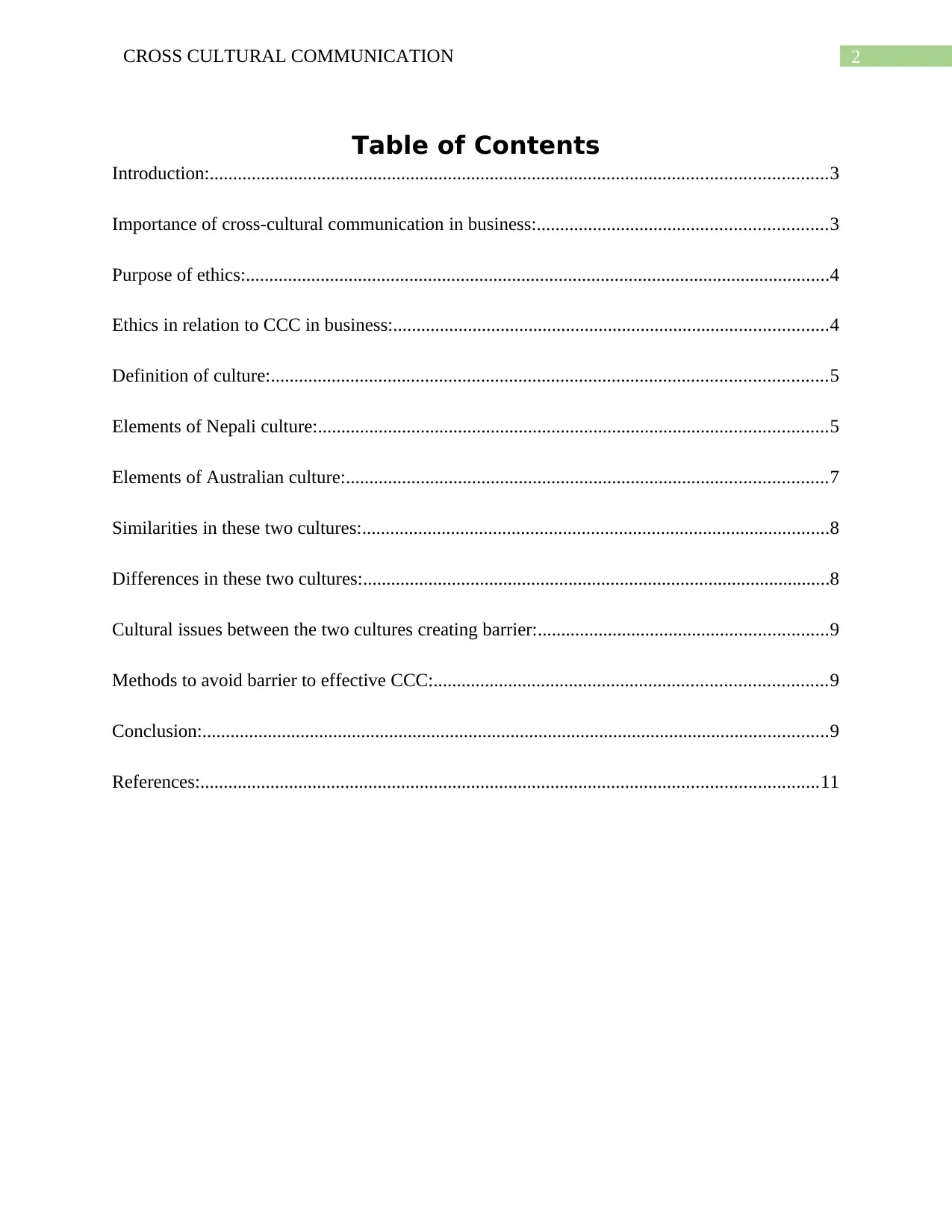
2CROSS CULTURAL COMMUNICATION
Table of Contents
Introduction:....................................................................................................................................3
Importance of cross-cultural communication in business:..............................................................3
Purpose of ethics:.............................................................................................................................4
Ethics in relation to CCC in business:.............................................................................................4
Definition of culture:.......................................................................................................................5
Elements of Nepali culture:.............................................................................................................5
Elements of Australian culture:.......................................................................................................7
Similarities in these two cultures:....................................................................................................8
Differences in these two cultures:....................................................................................................8
Cultural issues between the two cultures creating barrier:..............................................................9
Methods to avoid barrier to effective CCC:....................................................................................9
Conclusion:......................................................................................................................................9
References:....................................................................................................................................11
Table of Contents
Introduction:....................................................................................................................................3
Importance of cross-cultural communication in business:..............................................................3
Purpose of ethics:.............................................................................................................................4
Ethics in relation to CCC in business:.............................................................................................4
Definition of culture:.......................................................................................................................5
Elements of Nepali culture:.............................................................................................................5
Elements of Australian culture:.......................................................................................................7
Similarities in these two cultures:....................................................................................................8
Differences in these two cultures:....................................................................................................8
Cultural issues between the two cultures creating barrier:..............................................................9
Methods to avoid barrier to effective CCC:....................................................................................9
Conclusion:......................................................................................................................................9
References:....................................................................................................................................11
⊘ This is a preview!⊘
Do you want full access?
Subscribe today to unlock all pages.

Trusted by 1+ million students worldwide
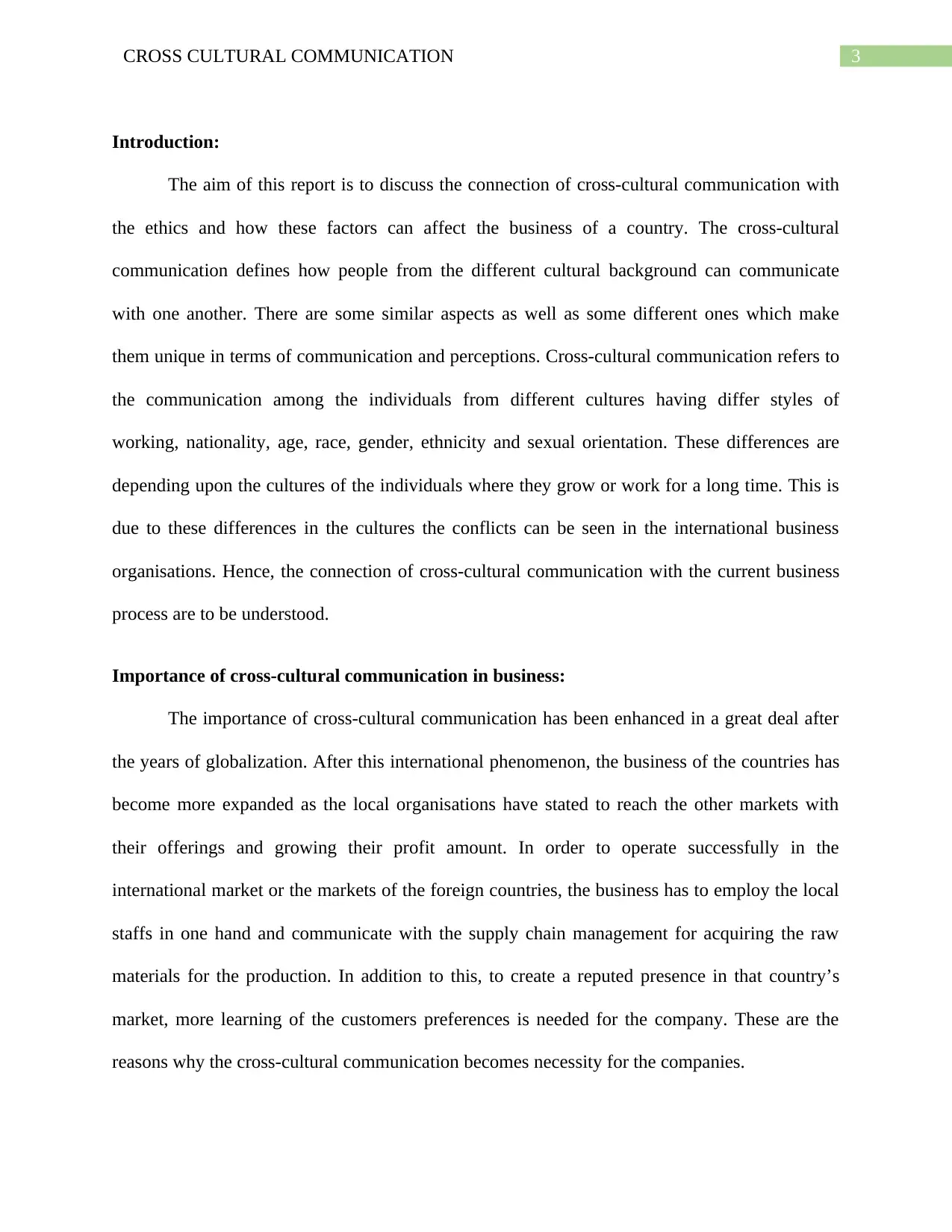
3CROSS CULTURAL COMMUNICATION
Introduction:
The aim of this report is to discuss the connection of cross-cultural communication with
the ethics and how these factors can affect the business of a country. The cross-cultural
communication defines how people from the different cultural background can communicate
with one another. There are some similar aspects as well as some different ones which make
them unique in terms of communication and perceptions. Cross-cultural communication refers to
the communication among the individuals from different cultures having differ styles of
working, nationality, age, race, gender, ethnicity and sexual orientation. These differences are
depending upon the cultures of the individuals where they grow or work for a long time. This is
due to these differences in the cultures the conflicts can be seen in the international business
organisations. Hence, the connection of cross-cultural communication with the current business
process are to be understood.
Importance of cross-cultural communication in business:
The importance of cross-cultural communication has been enhanced in a great deal after
the years of globalization. After this international phenomenon, the business of the countries has
become more expanded as the local organisations have stated to reach the other markets with
their offerings and growing their profit amount. In order to operate successfully in the
international market or the markets of the foreign countries, the business has to employ the local
staffs in one hand and communicate with the supply chain management for acquiring the raw
materials for the production. In addition to this, to create a reputed presence in that country’s
market, more learning of the customers preferences is needed for the company. These are the
reasons why the cross-cultural communication becomes necessity for the companies.
Introduction:
The aim of this report is to discuss the connection of cross-cultural communication with
the ethics and how these factors can affect the business of a country. The cross-cultural
communication defines how people from the different cultural background can communicate
with one another. There are some similar aspects as well as some different ones which make
them unique in terms of communication and perceptions. Cross-cultural communication refers to
the communication among the individuals from different cultures having differ styles of
working, nationality, age, race, gender, ethnicity and sexual orientation. These differences are
depending upon the cultures of the individuals where they grow or work for a long time. This is
due to these differences in the cultures the conflicts can be seen in the international business
organisations. Hence, the connection of cross-cultural communication with the current business
process are to be understood.
Importance of cross-cultural communication in business:
The importance of cross-cultural communication has been enhanced in a great deal after
the years of globalization. After this international phenomenon, the business of the countries has
become more expanded as the local organisations have stated to reach the other markets with
their offerings and growing their profit amount. In order to operate successfully in the
international market or the markets of the foreign countries, the business has to employ the local
staffs in one hand and communicate with the supply chain management for acquiring the raw
materials for the production. In addition to this, to create a reputed presence in that country’s
market, more learning of the customers preferences is needed for the company. These are the
reasons why the cross-cultural communication becomes necessity for the companies.
Paraphrase This Document
Need a fresh take? Get an instant paraphrase of this document with our AI Paraphraser
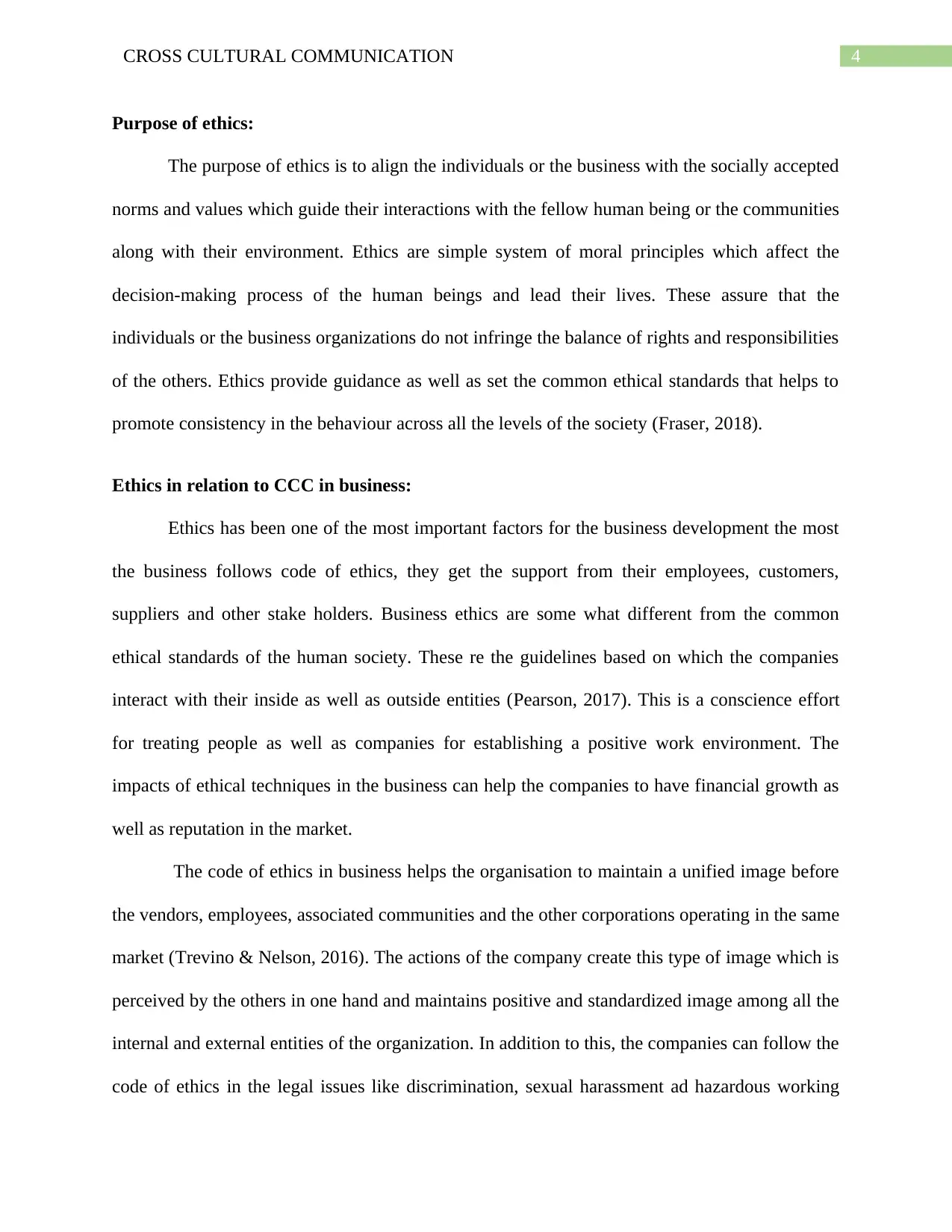
4CROSS CULTURAL COMMUNICATION
Purpose of ethics:
The purpose of ethics is to align the individuals or the business with the socially accepted
norms and values which guide their interactions with the fellow human being or the communities
along with their environment. Ethics are simple system of moral principles which affect the
decision-making process of the human beings and lead their lives. These assure that the
individuals or the business organizations do not infringe the balance of rights and responsibilities
of the others. Ethics provide guidance as well as set the common ethical standards that helps to
promote consistency in the behaviour across all the levels of the society (Fraser, 2018).
Ethics in relation to CCC in business:
Ethics has been one of the most important factors for the business development the most
the business follows code of ethics, they get the support from their employees, customers,
suppliers and other stake holders. Business ethics are some what different from the common
ethical standards of the human society. These re the guidelines based on which the companies
interact with their inside as well as outside entities (Pearson, 2017). This is a conscience effort
for treating people as well as companies for establishing a positive work environment. The
impacts of ethical techniques in the business can help the companies to have financial growth as
well as reputation in the market.
The code of ethics in business helps the organisation to maintain a unified image before
the vendors, employees, associated communities and the other corporations operating in the same
market (Trevino & Nelson, 2016). The actions of the company create this type of image which is
perceived by the others in one hand and maintains positive and standardized image among all the
internal and external entities of the organization. In addition to this, the companies can follow the
code of ethics in the legal issues like discrimination, sexual harassment ad hazardous working
Purpose of ethics:
The purpose of ethics is to align the individuals or the business with the socially accepted
norms and values which guide their interactions with the fellow human being or the communities
along with their environment. Ethics are simple system of moral principles which affect the
decision-making process of the human beings and lead their lives. These assure that the
individuals or the business organizations do not infringe the balance of rights and responsibilities
of the others. Ethics provide guidance as well as set the common ethical standards that helps to
promote consistency in the behaviour across all the levels of the society (Fraser, 2018).
Ethics in relation to CCC in business:
Ethics has been one of the most important factors for the business development the most
the business follows code of ethics, they get the support from their employees, customers,
suppliers and other stake holders. Business ethics are some what different from the common
ethical standards of the human society. These re the guidelines based on which the companies
interact with their inside as well as outside entities (Pearson, 2017). This is a conscience effort
for treating people as well as companies for establishing a positive work environment. The
impacts of ethical techniques in the business can help the companies to have financial growth as
well as reputation in the market.
The code of ethics in business helps the organisation to maintain a unified image before
the vendors, employees, associated communities and the other corporations operating in the same
market (Trevino & Nelson, 2016). The actions of the company create this type of image which is
perceived by the others in one hand and maintains positive and standardized image among all the
internal and external entities of the organization. In addition to this, the companies can follow the
code of ethics in the legal issues like discrimination, sexual harassment ad hazardous working

5CROSS CULTURAL COMMUNICATION
conditions (Crane & Matten, 2016). Code of ethics is also import for developing and maintaining
the business relationships of the companies in the competitive market system. Based on the
ethical models, the companies can maintain positive professional reputation among the clients,
potential business partners and vendors. Good business ethics helps the organisations to creates
business relationship and result in the repeat business from the clients, lower the product costs
and enhance sources of finance.
Definition of culture:
Culture is defined by the characteristics and knowledge of the specific group of people
that encompass religion, language, music, social habits and arts. The culture can also be defined
as the shared patterns of interactions and behaviour, cognitive constricts along with
understanding which are learned by socialization. Therefore, culture can be seen as the factor of
development of a group identity that are fostered by the unique social patterns of the group.
Different nations follow different ethnicity and culture (Almond & Verba, 2015). This relates
differences among themselves. In some cases, the cultures of the two neighbouring countries do
not have the same cultures. For instance, the culture of China and India are completely different.
Despite the fact that these two are neighbouring nations but the ethnicity or culture that depends
upon the religion, philosophy, food habits, perceptions of the life are completely different from
each other (Inglehart, 2018).
Elements of Nepali culture:
Nepal in spite of being a small country in the Himalayas, its customs and the traditions
differ from place to place. The conglomeration lies in Kathmandu, the capital city of Nepal
which serves to be the cultural metropolis of the country. Nepal has been a secular country after
its parliament announced its so in 2006. The religions like Hinduism, Buddhism, Jainism,
conditions (Crane & Matten, 2016). Code of ethics is also import for developing and maintaining
the business relationships of the companies in the competitive market system. Based on the
ethical models, the companies can maintain positive professional reputation among the clients,
potential business partners and vendors. Good business ethics helps the organisations to creates
business relationship and result in the repeat business from the clients, lower the product costs
and enhance sources of finance.
Definition of culture:
Culture is defined by the characteristics and knowledge of the specific group of people
that encompass religion, language, music, social habits and arts. The culture can also be defined
as the shared patterns of interactions and behaviour, cognitive constricts along with
understanding which are learned by socialization. Therefore, culture can be seen as the factor of
development of a group identity that are fostered by the unique social patterns of the group.
Different nations follow different ethnicity and culture (Almond & Verba, 2015). This relates
differences among themselves. In some cases, the cultures of the two neighbouring countries do
not have the same cultures. For instance, the culture of China and India are completely different.
Despite the fact that these two are neighbouring nations but the ethnicity or culture that depends
upon the religion, philosophy, food habits, perceptions of the life are completely different from
each other (Inglehart, 2018).
Elements of Nepali culture:
Nepal in spite of being a small country in the Himalayas, its customs and the traditions
differ from place to place. The conglomeration lies in Kathmandu, the capital city of Nepal
which serves to be the cultural metropolis of the country. Nepal has been a secular country after
its parliament announced its so in 2006. The religions like Hinduism, Buddhism, Jainism,
⊘ This is a preview!⊘
Do you want full access?
Subscribe today to unlock all pages.

Trusted by 1+ million students worldwide
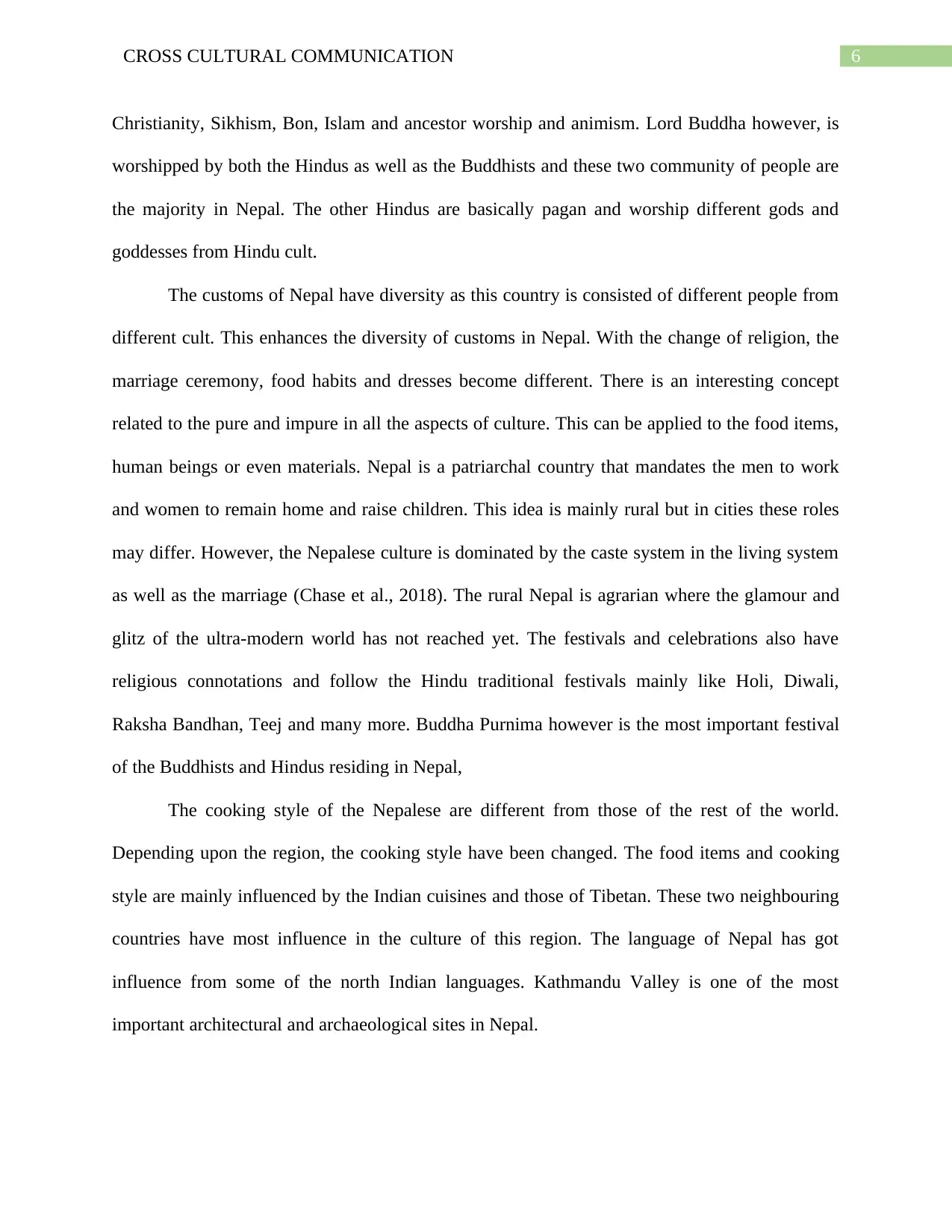
6CROSS CULTURAL COMMUNICATION
Christianity, Sikhism, Bon, Islam and ancestor worship and animism. Lord Buddha however, is
worshipped by both the Hindus as well as the Buddhists and these two community of people are
the majority in Nepal. The other Hindus are basically pagan and worship different gods and
goddesses from Hindu cult.
The customs of Nepal have diversity as this country is consisted of different people from
different cult. This enhances the diversity of customs in Nepal. With the change of religion, the
marriage ceremony, food habits and dresses become different. There is an interesting concept
related to the pure and impure in all the aspects of culture. This can be applied to the food items,
human beings or even materials. Nepal is a patriarchal country that mandates the men to work
and women to remain home and raise children. This idea is mainly rural but in cities these roles
may differ. However, the Nepalese culture is dominated by the caste system in the living system
as well as the marriage (Chase et al., 2018). The rural Nepal is agrarian where the glamour and
glitz of the ultra-modern world has not reached yet. The festivals and celebrations also have
religious connotations and follow the Hindu traditional festivals mainly like Holi, Diwali,
Raksha Bandhan, Teej and many more. Buddha Purnima however is the most important festival
of the Buddhists and Hindus residing in Nepal,
The cooking style of the Nepalese are different from those of the rest of the world.
Depending upon the region, the cooking style have been changed. The food items and cooking
style are mainly influenced by the Indian cuisines and those of Tibetan. These two neighbouring
countries have most influence in the culture of this region. The language of Nepal has got
influence from some of the north Indian languages. Kathmandu Valley is one of the most
important architectural and archaeological sites in Nepal.
Christianity, Sikhism, Bon, Islam and ancestor worship and animism. Lord Buddha however, is
worshipped by both the Hindus as well as the Buddhists and these two community of people are
the majority in Nepal. The other Hindus are basically pagan and worship different gods and
goddesses from Hindu cult.
The customs of Nepal have diversity as this country is consisted of different people from
different cult. This enhances the diversity of customs in Nepal. With the change of religion, the
marriage ceremony, food habits and dresses become different. There is an interesting concept
related to the pure and impure in all the aspects of culture. This can be applied to the food items,
human beings or even materials. Nepal is a patriarchal country that mandates the men to work
and women to remain home and raise children. This idea is mainly rural but in cities these roles
may differ. However, the Nepalese culture is dominated by the caste system in the living system
as well as the marriage (Chase et al., 2018). The rural Nepal is agrarian where the glamour and
glitz of the ultra-modern world has not reached yet. The festivals and celebrations also have
religious connotations and follow the Hindu traditional festivals mainly like Holi, Diwali,
Raksha Bandhan, Teej and many more. Buddha Purnima however is the most important festival
of the Buddhists and Hindus residing in Nepal,
The cooking style of the Nepalese are different from those of the rest of the world.
Depending upon the region, the cooking style have been changed. The food items and cooking
style are mainly influenced by the Indian cuisines and those of Tibetan. These two neighbouring
countries have most influence in the culture of this region. The language of Nepal has got
influence from some of the north Indian languages. Kathmandu Valley is one of the most
important architectural and archaeological sites in Nepal.
Paraphrase This Document
Need a fresh take? Get an instant paraphrase of this document with our AI Paraphraser
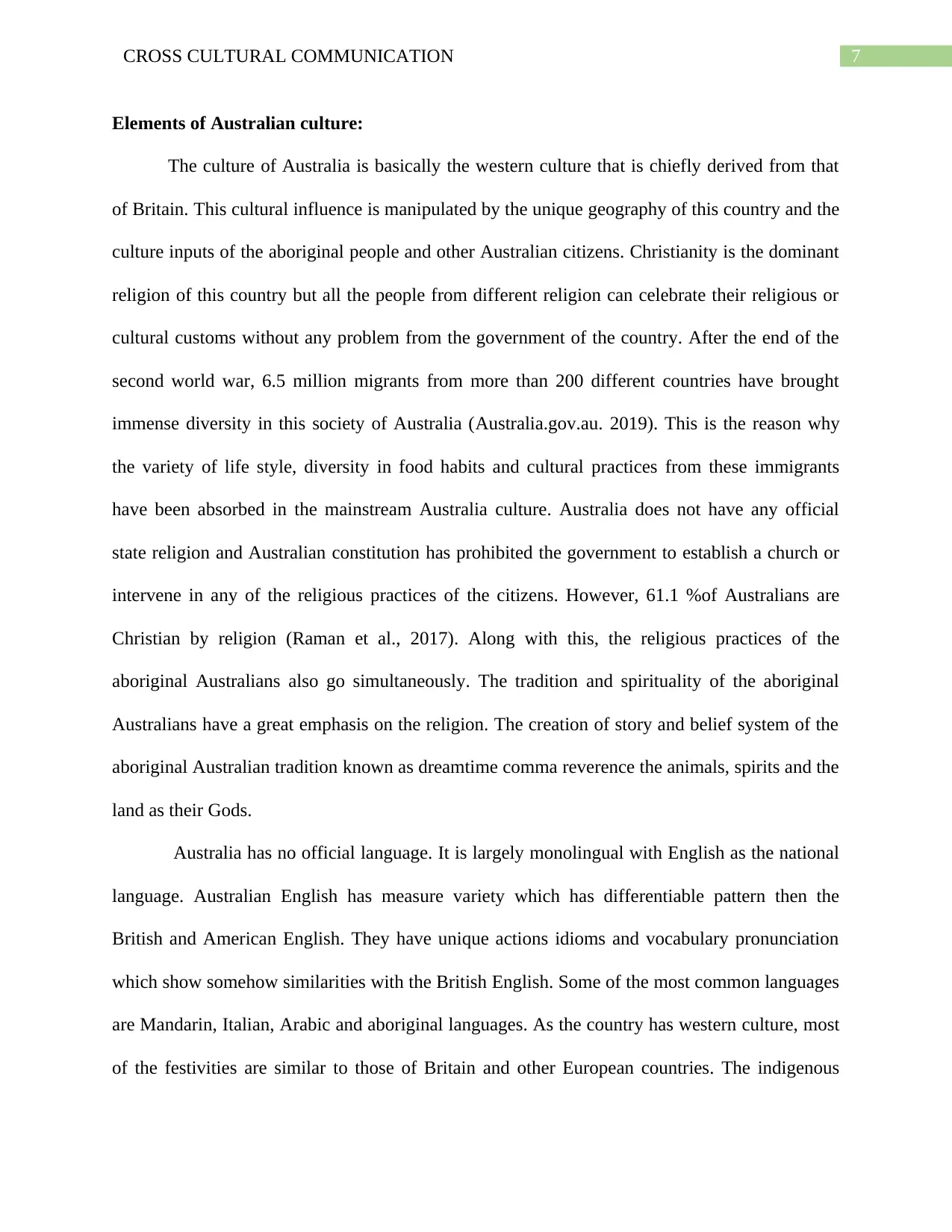
7CROSS CULTURAL COMMUNICATION
Elements of Australian culture:
The culture of Australia is basically the western culture that is chiefly derived from that
of Britain. This cultural influence is manipulated by the unique geography of this country and the
culture inputs of the aboriginal people and other Australian citizens. Christianity is the dominant
religion of this country but all the people from different religion can celebrate their religious or
cultural customs without any problem from the government of the country. After the end of the
second world war, 6.5 million migrants from more than 200 different countries have brought
immense diversity in this society of Australia (Australia.gov.au. 2019). This is the reason why
the variety of life style, diversity in food habits and cultural practices from these immigrants
have been absorbed in the mainstream Australia culture. Australia does not have any official
state religion and Australian constitution has prohibited the government to establish a church or
intervene in any of the religious practices of the citizens. However, 61.1 %of Australians are
Christian by religion (Raman et al., 2017). Along with this, the religious practices of the
aboriginal Australians also go simultaneously. The tradition and spirituality of the aboriginal
Australians have a great emphasis on the religion. The creation of story and belief system of the
aboriginal Australian tradition known as dreamtime comma reverence the animals, spirits and the
land as their Gods.
Australia has no official language. It is largely monolingual with English as the national
language. Australian English has measure variety which has differentiable pattern then the
British and American English. They have unique actions idioms and vocabulary pronunciation
which show somehow similarities with the British English. Some of the most common languages
are Mandarin, Italian, Arabic and aboriginal languages. As the country has western culture, most
of the festivities are similar to those of Britain and other European countries. The indigenous
Elements of Australian culture:
The culture of Australia is basically the western culture that is chiefly derived from that
of Britain. This cultural influence is manipulated by the unique geography of this country and the
culture inputs of the aboriginal people and other Australian citizens. Christianity is the dominant
religion of this country but all the people from different religion can celebrate their religious or
cultural customs without any problem from the government of the country. After the end of the
second world war, 6.5 million migrants from more than 200 different countries have brought
immense diversity in this society of Australia (Australia.gov.au. 2019). This is the reason why
the variety of life style, diversity in food habits and cultural practices from these immigrants
have been absorbed in the mainstream Australia culture. Australia does not have any official
state religion and Australian constitution has prohibited the government to establish a church or
intervene in any of the religious practices of the citizens. However, 61.1 %of Australians are
Christian by religion (Raman et al., 2017). Along with this, the religious practices of the
aboriginal Australians also go simultaneously. The tradition and spirituality of the aboriginal
Australians have a great emphasis on the religion. The creation of story and belief system of the
aboriginal Australian tradition known as dreamtime comma reverence the animals, spirits and the
land as their Gods.
Australia has no official language. It is largely monolingual with English as the national
language. Australian English has measure variety which has differentiable pattern then the
British and American English. They have unique actions idioms and vocabulary pronunciation
which show somehow similarities with the British English. Some of the most common languages
are Mandarin, Italian, Arabic and aboriginal languages. As the country has western culture, most
of the festivities are similar to those of Britain and other European countries. The indigenous

8CROSS CULTURAL COMMUNICATION
people have their own set of celebrations which have religious connotations with them (Lake,
2017). Along with this, there are some very important carnivals arranged by the tourism sector so
that more people around this world can be attracted to visit Australia. Among this the world cup
of cricket and various other sports events can be named.
This culture has well established literature, theatre, art and architecture. In various cities
of Australia one can find 3 architectural listings by UNESCO’s World Heritage list (Kidd et al.,
2016). The culture of aboriginal Australians has their own style of art music and dance. The
aboriginal rock art is one of the oldest continuous art traditions which dates back more than
60000 years. They have distinguishable music which is an integral part of their culture. The most
famous feature of aboriginal music of Australia is the Didgeridoo which is a wooden instrument
used by the aboriginal performers. Contemporary Australian cuisine has a good combination of
British as well as indigenous origin along with some Asian influences. The abundant natural
resources of Australia allow a large variety of quality meats to access. Along with this seafood in
the Australian region is very much popular among the residents here.
Similarities in these two cultures:
Both the cultures of Nepal and Australia are secular in religion and people residing there
do not feel pressure to follow the state religion.
Both have their own customs and practices which are gradually changing with the advent
of western culture.
Differences in these two cultures:
Unlike the Australians, Nepalese culture has caste system which they strictly follow in
marriage or any other religious actives.
people have their own set of celebrations which have religious connotations with them (Lake,
2017). Along with this, there are some very important carnivals arranged by the tourism sector so
that more people around this world can be attracted to visit Australia. Among this the world cup
of cricket and various other sports events can be named.
This culture has well established literature, theatre, art and architecture. In various cities
of Australia one can find 3 architectural listings by UNESCO’s World Heritage list (Kidd et al.,
2016). The culture of aboriginal Australians has their own style of art music and dance. The
aboriginal rock art is one of the oldest continuous art traditions which dates back more than
60000 years. They have distinguishable music which is an integral part of their culture. The most
famous feature of aboriginal music of Australia is the Didgeridoo which is a wooden instrument
used by the aboriginal performers. Contemporary Australian cuisine has a good combination of
British as well as indigenous origin along with some Asian influences. The abundant natural
resources of Australia allow a large variety of quality meats to access. Along with this seafood in
the Australian region is very much popular among the residents here.
Similarities in these two cultures:
Both the cultures of Nepal and Australia are secular in religion and people residing there
do not feel pressure to follow the state religion.
Both have their own customs and practices which are gradually changing with the advent
of western culture.
Differences in these two cultures:
Unlike the Australians, Nepalese culture has caste system which they strictly follow in
marriage or any other religious actives.
⊘ This is a preview!⊘
Do you want full access?
Subscribe today to unlock all pages.

Trusted by 1+ million students worldwide

9CROSS CULTURAL COMMUNICATION
Nepal does not have distinguishable aboriginal culture but the culture they follow, has an
ancient tradition.
Most of the people in Australia are Christian where as Nepalese are either Hindu or
Buddhist.
The seafood in the Australian region is much popular which is absent in Nepal.
Cultural issues between the two cultures creating barrier:
Nepal has patriarchal society which cannot be supported in the culture of Australia
The Nepalese idea of pure and impure may create issues in Australia
The caste system in Nepal may not be acceptable in the modern society of Australia.
Methods to avoid barrier to effective CCC:
In order to avoid barrier of successful cross-cultural communication between Nepalese culture
and Australian culture, one must follow the practices which include-
Maintaining etiquette and show respect to the cultural traditions and customs
Speaking slowly can help to understand the message more effectively
Practicing active listening to what are being told can engage attention and reduces any
probability of miscommunication.
By keeping things simple, the cross-cultural communication can be more effective
Conclusion:
Therefore, it can eb concluded that the culture of Nepal and Australia are completely
different from each other which may lead to misinterpretation among the communicators. The
business which is operating globally must follow the code of ethics and successful cross-cultural
communication so that the sustainable growth can be achieved in a more effective way.
Nepal does not have distinguishable aboriginal culture but the culture they follow, has an
ancient tradition.
Most of the people in Australia are Christian where as Nepalese are either Hindu or
Buddhist.
The seafood in the Australian region is much popular which is absent in Nepal.
Cultural issues between the two cultures creating barrier:
Nepal has patriarchal society which cannot be supported in the culture of Australia
The Nepalese idea of pure and impure may create issues in Australia
The caste system in Nepal may not be acceptable in the modern society of Australia.
Methods to avoid barrier to effective CCC:
In order to avoid barrier of successful cross-cultural communication between Nepalese culture
and Australian culture, one must follow the practices which include-
Maintaining etiquette and show respect to the cultural traditions and customs
Speaking slowly can help to understand the message more effectively
Practicing active listening to what are being told can engage attention and reduces any
probability of miscommunication.
By keeping things simple, the cross-cultural communication can be more effective
Conclusion:
Therefore, it can eb concluded that the culture of Nepal and Australia are completely
different from each other which may lead to misinterpretation among the communicators. The
business which is operating globally must follow the code of ethics and successful cross-cultural
communication so that the sustainable growth can be achieved in a more effective way.
Paraphrase This Document
Need a fresh take? Get an instant paraphrase of this document with our AI Paraphraser

10CROSS CULTURAL COMMUNICATION

11CROSS CULTURAL COMMUNICATION
References:
Almond, G. A., & Verba, S. (2015). The civic culture: Political attitudes and democracy in five
nations. Princeton university press.
Australia.gov.au. (2019). Retrieved from https://www.australia.gov.au/information-and-
services/immigration-and-visas/migration-to-australia
Chase, L. E., Sapkota, R. P., Crafa, D., & Kirmayer, L. J. (2018). Culture and mental health in
Nepal: an interdisciplinary scoping review. Global Mental Health, 5.
Crane, A., & Matten, D. (2016). Business ethics: Managing corporate citizenship and
sustainability in the age of globalization. Oxford University Press.
Fraser, N. (2018). Recognition without ethics?. In The culture of toleration in diverse societies.
Manchester University Press.
Inglehart, R. (2018). Culture shift in advanced industrial society. Princeton University Press.
Kidd, E., Kemp, N., Kashima, E. S., & Quinn, S. (2016). Language, Culture, and Group
Membership: An Investigation Into the Social Effects of Colloquial Australian
English. Journal of Cross-Cultural Psychology, 47(5), 713-733.
Lake, M. (2017). The bible in Australian history and culture. St Mark's Review, (240), 12.
Pearson, R. (2017). Business ethics as communication ethics: Public relations practice and the
idea of dialogue. In Public relations theory (pp. 111-131). Routledge.
Raman, S., Ruston, S., Irwin, S., Tran, P., Hotton, P., & Thorne, S. (2017). Taking culture
seriously: Can we improve the developmental health and well‐being of Australian
Aboriginal children in out‐of‐home care?. Child: care, health and development, 43(6),
899-905.
References:
Almond, G. A., & Verba, S. (2015). The civic culture: Political attitudes and democracy in five
nations. Princeton university press.
Australia.gov.au. (2019). Retrieved from https://www.australia.gov.au/information-and-
services/immigration-and-visas/migration-to-australia
Chase, L. E., Sapkota, R. P., Crafa, D., & Kirmayer, L. J. (2018). Culture and mental health in
Nepal: an interdisciplinary scoping review. Global Mental Health, 5.
Crane, A., & Matten, D. (2016). Business ethics: Managing corporate citizenship and
sustainability in the age of globalization. Oxford University Press.
Fraser, N. (2018). Recognition without ethics?. In The culture of toleration in diverse societies.
Manchester University Press.
Inglehart, R. (2018). Culture shift in advanced industrial society. Princeton University Press.
Kidd, E., Kemp, N., Kashima, E. S., & Quinn, S. (2016). Language, Culture, and Group
Membership: An Investigation Into the Social Effects of Colloquial Australian
English. Journal of Cross-Cultural Psychology, 47(5), 713-733.
Lake, M. (2017). The bible in Australian history and culture. St Mark's Review, (240), 12.
Pearson, R. (2017). Business ethics as communication ethics: Public relations practice and the
idea of dialogue. In Public relations theory (pp. 111-131). Routledge.
Raman, S., Ruston, S., Irwin, S., Tran, P., Hotton, P., & Thorne, S. (2017). Taking culture
seriously: Can we improve the developmental health and well‐being of Australian
Aboriginal children in out‐of‐home care?. Child: care, health and development, 43(6),
899-905.
⊘ This is a preview!⊘
Do you want full access?
Subscribe today to unlock all pages.

Trusted by 1+ million students worldwide
1 out of 13
Related Documents
Your All-in-One AI-Powered Toolkit for Academic Success.
+13062052269
info@desklib.com
Available 24*7 on WhatsApp / Email
![[object Object]](/_next/static/media/star-bottom.7253800d.svg)
Unlock your academic potential
Copyright © 2020–2025 A2Z Services. All Rights Reserved. Developed and managed by ZUCOL.





